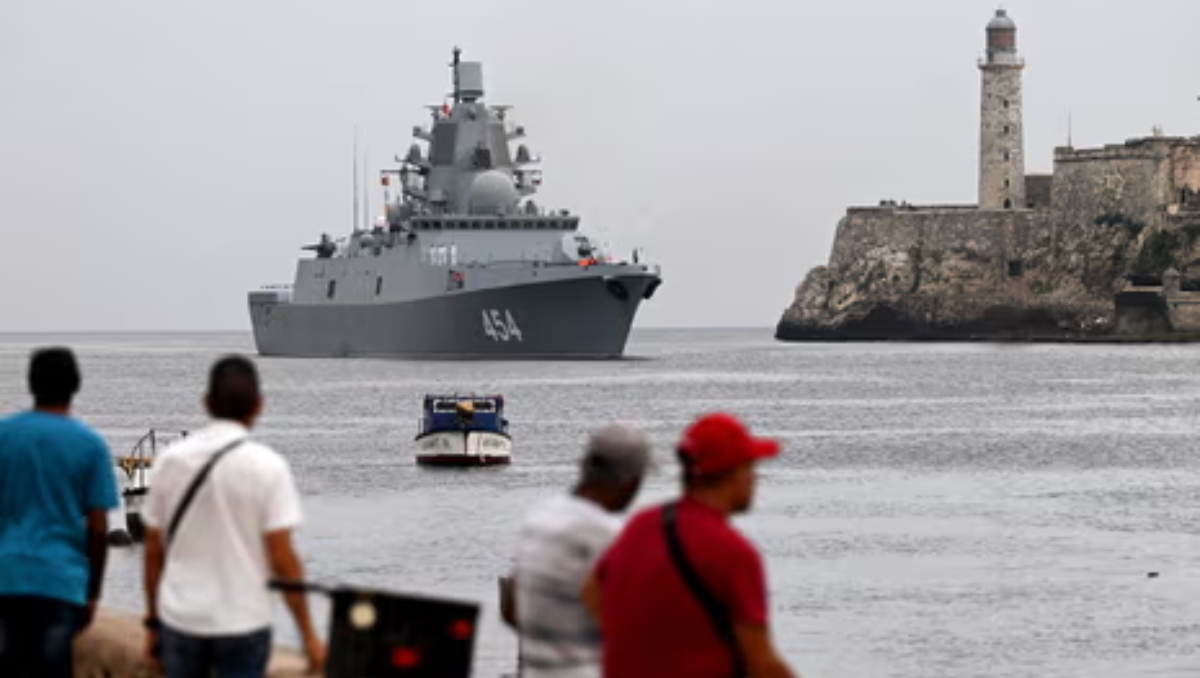Amid tensions with the West over assistance for Ukraine, a flotilla of Russian warships has arrived in Havana Bay, staging a show of power. Arriving at Havana Bay early on Wednesday, four ships including the nuclear-powered submarine Kazan and the frigate Admiral Gorshkov—offered a 21-gun salute from the battlements of La Cabaña, the fortress where Che Guevara formerly held his office.
Situated approximately 90 miles (145 km) away from the US state of Florida, the vessels are anchored in Havana Bay. Longtime Russian ally Cuba welcomed the ships’ arrival with cannon fire from the harbour, and as the ships passed the harbor’s historical structures, Russian diplomats waved tiny Russian flags and snapped photographs. Tugboat and fuel ship arrived earlier in the morning to accompany the nuclear-powered submarine Kazan, which was partially submerged with its crew on deck, and the Admiral Gorshkov frigate.
As per Russia’s defense ministry, both the Kazan submarine and the Admiral Gorshkov frigate are armed with state-of-the-art weapons, including the formidable Zircon hypersonic missiles. These weapons were recently tested in the Atlantic.
However, according to Cuba’s foreign ministry, none of the ships are carrying nuclear weapons, and the region is not in danger during their five-day stay.
Following “high-precision missile weapons” training in the Atlantic Ocean, the four Russian ships headed to Cuba on Wednesday, the Russian Defence Ministry announced on Wednesday. The Kazan submarine and the Admiral Gorshkov frigate are equipped with modern weaponry, including the potent Zircon hypersonic missiles.
It was clarified by Cuba last week that the visit of the fleet was a routine occurrence for naval ships from nations that support Havana. This was further confirmed by U.S. officials, who echoed the communist-run government’s foreign ministry’s statement that the fleet was not carrying any nuclear weapons.
US officials claim to be keeping a close eye on the visit. The US Navy also used naval drones to track the Russian vessels, a strategic move aimed at gathering intelligence and maintaining situational awareness, as reported by CBS. White House National Security Advisor Jake Sullivan told reporters such naval drills are standard on Wednesday. Russia does not appear to have been sending missiles to Cuba, according to Sullivan, but the United States will continue to be on guard.
Russia’s ministry of defense said in a statement that the crews of the vessels were able to “rest and get acquainted with local attractions” during their unofficial tour. Despite the long-standing alliance between the two countries and Russia’s previous dispatch of warships to Cuba, the timing of these specific drills is particularly significant.
The operation, which comes amid mounting tensions over Moscow’s full-scale invasion of Ukraine in 2022, is perceived by some as Moscow’s sabre-rattling. Undoubtedly, it seems to convey to Washington a very strong message about what the Kremlin views as encroachment into their territory.
Russia’s Historic ties
The visit is a significant show of solidarity for Cuba’s communist government and its socialist partner, Venezuela, where the naval vessels may go after leaving Havana. The visit comes at the time of Cuba’s worst economic and social crisis in decades, marked by shortages of fuel, food, and medicine, the time of Cuba’s worst economic and social crisis in decades, marked by shortages of fuel, food, and medicine as well as rising unrest on the streets.
The Cuban Missile Crisis began in 1962 when the Soviet Union sent ballistic missiles to Cuba in retaliation for an American missile installation in Turkey. This standoff put the world in danger of nuclear war. The two nations are reestablishing their relationship.
During his fourth visit to Russia in May, Cuban President Miguel Diaz-Canel wished Russian soldiers’ success in Ukraine and stated Moscow could always rely on Havana’s assistance. In March, Russia sent 90,000 metric tonnes of oil to Cuba to alleviate shortages. In addition, Moscow pledged to support Havana’s initiatives in the areas of infrastructure, renewable energy, tourism, and sugar production. It is anticipated that the ships would stay in Havana till June 17.

1 Comment
Pingback: US and Russian Nuclear Submarines Play 'Hide and Seek' in Cuba - INPAC Times